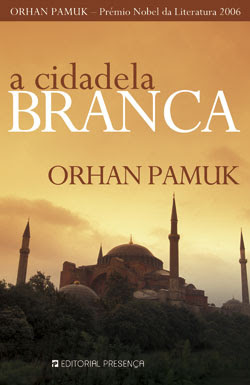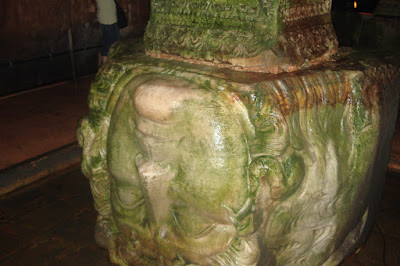A peregrinação inteior de Orhan
 Orhan Inner Pilgrimage
Orhan Inner PilgrimagePresently we live in a world whose essential reality rests upon the will of two duplicates, which now get closer, then stay far away from each other; now get similar, then get different; now join their spades against evil, then they engender it; now they are for each other, then they are against each other; now they devise an invincible machine, then they smash it: well, of two Gods. The God of the Christians and the God of the Muslims. And this could be the conclusion taken of what was not said but largely demonstrated in the White Cidadel, a novel in which story, plot and supposition balance on the borders of identity, swinging “on tiptoe” in an exercise of risk, in as much as “to be” is not unpunished, because “to be” one it takes to be the other, in the vice-versa of a mirror dance.
However, that crossed reflection, typical of the flickering writing between the lines, is not extinguished in the above mentioned work and can be the clue of signs for detectives committed in the revelation of the supreme crime, or the one that makes each one what it is and not other which he could equally be. Leading thread among incident reflections, traces of familiar sprinkling, flashes of memory on the river of forgetting, shades of undoubtable similarity among different tapestries of different craftsmen, in the disparity of motives, whether they are revealed to the sight and on the face, whether they are simply guessed as a possibility on the reverse. That’s why this presentation is, was, a gesture of resistance, an obliquely look that insists on recognizing that “when the garden of memory starts getting desert” as Djélâl had already said, “we tender its last trees and its last roses, we fear for them. To avoid that they dry and disappear, we smooth them, we water them from morning to night! We do nothing but remembering and remembering again, fearing to forget!”
To go through the imagetic universe of The Gardens of the Memories is to recognise how much permeable to common history we are and to allow it the transparency of the waters where will be reflected the inseparable futures of two worlds, which exerted the secular magic of making flourish the alchemy of the fusion again, changing the lead of the difference into the gold of identity, as true houroufis, initiated in the art of verbal play and punning of the old literature, inhabitants of the “Heart of the Cities”, watered by the rivers and seas of memories, whose tides fertilize its margins, filling them with the green ink of its trees (secular) in search for the secret and for the lost sense in the faces, cities which are the reunion of themselves, built from addresses, which are built from letters, and the letters built from the faces which teach the memory to read and write, just as the lead which changes the simple glass of transparency into the mirror of the secret, words that in Turkish are homographic and homophonous, which tell us that reading is looking at the mirror, but knowing the secret is being able to cross it, as all those that ignore the secret of the letters cannot but discover in this world the dullness, the banality of their own face.
“… “Remember me?” he asked the old journalist after a moment.
- Of course! You are also a flower in the garden of my memory! – Néchati answered without raising his head. – Who said that the memory was a garden?
- It was Djélâl Salik.
- No, it was Bottfolio. In his very classical translation of Ibn Zerhani. As always Djélâl Salik has stolen him that image. As you stole him his glasses.”
And saying glasses we say lens. And saying lens we say glass. And saying glass we say mirror… If, alas, we are able to put together enough and the necessary dose of (green) lead that History gave us. (Tradução de Margarida Coelho)

A peregrinação inteior de Orhan
Vivemos actualmente num mundo cuja realidade essencial se fundamenta na vontade de dois sósias, que ora se aproximam, ora se afastam; ora se assemelham, ora se diferenciam; ora unem as espadas contra o mal, ora o forjam; ora se pronunciam a favor um do outro, ora contra; ora inventam a máquina invencível, ora a desmantelam: enfim, de dois Deus. O Deus dos cristãos, e o Deus dos muçulmanos. E esta podia ser a ilação conclusiva de quanto não foi dito mas sobejamente demonstrado em A Cidadela Branca, onde a trama, o enredo, a conjectura, se equilibra nas fronteiras da identidade, balançando-se "pé ante pé" num exercício de risco, por quanto isso de ser não é impune, pois para se ser um obriga igualmente a ser-se o outro, no vice-versa duma dança de espelhos.
Todavia, esse reflectir entrecruzador, típico do entrelinhamento bruxuleado, não se esgota na obra citada e pode também ser pista de sinais para detectives empenhados na desvendação do crime supremo, ou aquele que faz com que cada um seja o que é, e não outro qualquer que podia igualmente ser. Fio condutor entre reflexos incidentes, traços de aspersão familiar, flashs da memória sobre o rio do esquecimento, matizes de inequívoca similaridade entre diferentes tapeçarias de diferentes artesãos, na disparidade dos motivos, quer eles se revelem à vista e no rosto, quer se adivinhem simplesmente como possibilidade no avesso. Por isso, esta apresentação é, foi, um gesto de resistência, um olhar de soslaio que insiste em reconhecer que "quando o jardim da memória começa a desertificar-se", como dissera Djélâl, "acarinhamos as suas últimas árvores e as suas últimas rosas, tememos por elas. Para evitar que sequem e desapareçam, acariciamo-las, regamo-las de manhã à noite! Não fazemos outra coisa que não seja recordar e voltar a recordar, com medo de esquecer!"
Atravessar o universo imagético de Os Jardins das Memórias, é reconhecer quanto somos permeáveis à história comum e permitir-lhe a transparência das águas onde se reflectirão os futuros inseparáveis de dois mundos que exerceram a magia secular de fazer reflorir a alquimia da fusão, transformando o chumbo da diferença em ouro da identidade, como autênticos houroufis, iniciados na arte dos jogos verbais e dos trocadilhos da literatura antiga, habitantes do "Coração das Cidades", irrigadas pelos rios e mares da memória, cujas marés fertilizam as suas margens, impregnando-as da verde tinta das suas árvores (seculares) na busca do segredo e do sentido perdidos nos rostos, cidades que são a reunião de si mesmas, construídas a partir de endereços, estes a partir de letras, e as letras a partir dos rostos que nos alfabetizam a memória, qual estanho que transforma o simples vidro da transparência em espelho do segredo, palavras que em turco são homógrafas e homófonas, e nos indica que ler é olhar o espelho, mas conhecer o segredo é poder atravessá-lo, porquanto todos os que ignoram o segredo das letras não podem descobrir neste mundo senão a insipidez, a banalidade do seu próprio rosto.
" ...«Lembra-se de mim?» perguntou ao fim de um momento o velho jornalista.
– Claro! Também você é uma flor no jardim da minha memória! – respondeu Néchati, sem levantar a cabeça. – Quem foi que disse que a memória era um jardim?
– Foi Djélâl Salik.
– Não, foi Bottfolio. Na sua tradução muito clássica de Ibn Zerhani. Como sempre o Djélâl Salik roubou-lhe essa imagem. Como você lhe roubou os óculos a ele." – página 323.
 E quem diz óculos diz lente. E quem diz lente diz vidro. E quem diz vidro diz espelho... Se, enfim, lhe soubermos juntar a dose suficiente e necessária de (verde) estanho que a História nos forneceu.
E quem diz óculos diz lente. E quem diz lente diz vidro. E quem diz vidro diz espelho... Se, enfim, lhe soubermos juntar a dose suficiente e necessária de (verde) estanho que a História nos forneceu.

Comentários